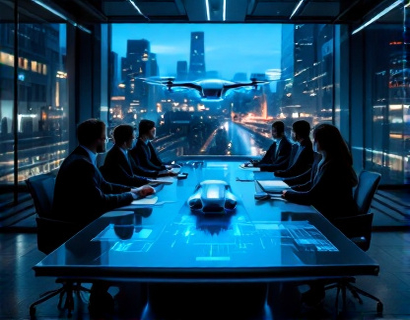Revolutionizing Aerospace Efficiency: Cutting-Edge Innovations for Industry Leaders
The aerospace industry stands at the precipice of a new era, driven by technological advancements that promise to redefine efficiency, safety, and performance. As industry leaders and visionaries, embracing these innovations is crucial to staying ahead in a competitive landscape. This article delves into the cutting-edge technologies and strategies that are reshaping the future of aerospace engineering, offering a forward-looking perspective for professionals and innovators in the field.
Advanced Materials: The Backbone of Efficiency
One of the most significant advancements in aerospace efficiency comes from the development and application of advanced materials. Composites, such as carbon fiber reinforced polymers, have revolutionized aircraft design by offering a superior strength-to-weight ratio compared to traditional metals. These materials reduce the overall weight of the aircraft, leading to lower fuel consumption and increased range. Moreover, the use of titanium alloys and advanced aluminum-lithium alloys has further enhanced structural integrity while reducing weight.
Beyond traditional materials, researchers are exploring the potential of smart materials that can adapt to changing conditions. Shape memory alloys, for instance, can change their shape in response to temperature variations, enabling the creation of morphing wings that optimize aerodynamic performance during different phases of flight. These innovations not only improve efficiency but also enhance the durability and maintenance requirements of aerospace vehicles.
Electric and Hybrid Propulsion Systems
The shift towards electric and hybrid propulsion systems represents a paradigm shift in aerospace efficiency. Electric motors offer higher efficiency and lower emissions compared to conventional jet engines, making them an attractive option for short to medium-range flights. Companies are already developing electric propulsion systems for drones and small aircraft, with plans to scale up for larger vehicles.
Hybrid propulsion systems combine electric motors with traditional jet engines to optimize fuel efficiency and reduce emissions. These systems can switch between electric and combustion modes based on flight conditions, providing the best of both worlds. As battery technology advances and energy density increases, the viability of electric and hybrid propulsion for commercial aviation will continue to grow, paving the way for a more sustainable future in air travel.
Artificial Intelligence and Autonomous Systems
Artificial intelligence (AI) and autonomous systems are transforming the aerospace industry by enhancing safety, efficiency, and operational capabilities. AI algorithms can process vast amounts of data in real-time, enabling predictive maintenance, optimized flight paths, and improved decision-making. For instance, AI-driven systems can analyze sensor data to detect potential issues before they become critical, reducing downtime and maintenance costs.
Autonomous drones and unmanned aerial vehicles (UAVs) are already being used for a variety of applications, from surveillance and inspection to cargo transport. These systems can operate in environments hazardous to humans, performing tasks with precision and reliability. As AI technology advances, the potential for fully autonomous commercial aircraft becomes increasingly plausible, promising to revolutionize air travel by reducing human error and increasing operational efficiency.
Sustainable Aviation Fuels
Sustainability is a critical concern in the aerospace industry, and the development of sustainable aviation fuels (SAFs) is a key component of this effort. SAFs are derived from renewable resources such as agricultural waste, algae, and used cooking oil, offering a significant reduction in carbon emissions compared to traditional jet fuel. These fuels can be used in existing aircraft engines with minimal modifications, making them a practical solution for the current fleet.
Several airlines and fuel producers are already investing in SAF production and distribution. Governments and international organizations are providing incentives to accelerate the adoption of these fuels. As the supply chain matures and costs decrease, SAFs will play a crucial role in achieving the industry's sustainability goals, ensuring that air travel can continue to grow while minimizing its environmental impact.
Advanced Avionics and Flight Control Systems
Advancements in avionics and flight control systems are enhancing the safety and efficiency of aerospace operations. Modern avionics integrate various systems, such as navigation, communication, and surveillance, into a single, user-friendly interface. This integration reduces pilot workload and improves situational awareness, leading to safer flights.
Fly-by-wire systems, which use electronic signals instead of mechanical linkages, offer greater precision and control. These systems can be enhanced with AI and machine learning algorithms to predict and mitigate potential issues, further enhancing safety. Additionally, advanced flight control systems can optimize flight paths in real-time, taking into account weather conditions, air traffic, and other factors to minimize fuel consumption and travel time.
Space Exploration Innovations
The aerospace industry is not limited to Earth's atmosphere; space exploration is another frontier where innovation is driving efficiency and performance. Reusable rockets, developed by companies like SpaceX, have significantly reduced the cost of access to space. By landing and reusing rocket boosters, these systems eliminate the need to build new rockets for each mission, making space travel more economically viable.
In-orbit servicing and maintenance are also becoming increasingly important as the number of satellites and space stations grows. Robotic systems capable of performing repairs and upgrades in space can extend the lifespan of these assets, reducing the need for frequent launches and lowering overall costs. Additionally, advancements in propulsion technology, such as ion drives and nuclear thermal propulsion, promise to enable faster and more efficient missions to distant destinations in our solar system.
Conclusion
The aerospace industry is on the cusp of a transformative era, driven by a convergence of advanced materials, electric and hybrid propulsion, AI and autonomous systems, sustainable fuels, and cutting-edge avionics. These innovations not only enhance efficiency and performance but also address critical challenges such as environmental sustainability and safety. As industry leaders, embracing these technologies is essential to remain competitive and drive the future of aerospace engineering. The path ahead is exciting, and the potential for breakthroughs is immense.










































